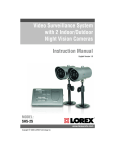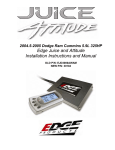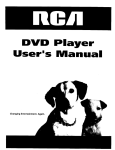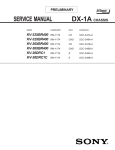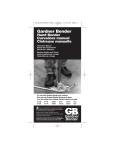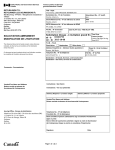Download service manual ra-4bchassis - Penn State PHP Service
Transcript
HISTORY INFORMATION FOR THE FOLLOWING MANUAL: RA-4B CHASSIS SERVICE MANUAL MODEL NAME KP-53HS10 KP-53HS10 KP-61HS10 KP-61HS10 ☛ REMOTE COMMANDER DESTINATION CHASSIS NO. RM-Y902 US SCC-P40A-A RM-Y902 Canadian SCC-P40A-A RM-Y902 US SCC-P40B-A RM-Y902 Canadian SCC-P40B-A :Updated Item ORIGINAL MANUAL ISSUE DATE: 3/2000 ALL REVISIONS AND UPDATES TO THE ORIGINAL MANUAL ARE APPENDED TO THE END OF THE PDF FILE. REVISION DATE REVISION TYPE SUBJECT 3/2000 6/2002 1/2004 No revisions or updates are applicable at this time. Correction - 1 D Board Corrections - Q5031 Voltage; Waveforms. Update Updated P. 205 of Electrical Parts List - Corrected P/N for F6105 and F6106 COLOR REAR VIDEO PROJECTOR 9-965-411-03 SERVICE MANUAL MODEL –––––––– COMMANDER DEST. CHASSIS NO. ––––––––––––––– –––––– –––––––––––––– KP-53HS10 KP-53HS10 KP-61HS10 KP-61HS10 MUTING SYSTEM OFF FUNCTION OFF DVD/ VTR RM-Y902 RM-Y902 RM-Y902 RM-Y902 POWER DBS CABLE DVD/VTR DBS/CABLE US MODEL –––––––– RA-4B CHASSIS COMMANDER DEST. CHASSIS NO. ––––––––––––––– –––––– –––––––––––––– SCC-P40A-A Canadian SCC-P40A-A US SCC-P40B-A Canadian SCC-P40B-A TV TV FREEZE AUDIO SWAP POTITION TV/DBS GUIDE CC ZOOM IN LEFT RIGHT ACTIVE PICTURE MODE DISPLAY TV/VIDEO ANT 1 2 3 4 5 7 8 JUMP 6 9 ENTER 0 MENU VOL CH RESET TV RM-Y902 KP-53HS10 KP-61HS10 COLOR REAR VIDEO PROJECTOR ∗ Please file according to model size. ....... 53 61 KP-53HS10/61HS10 RM-Y902 RM-Y902 SPECIFICATIONS –2– KP-53HS10/61HS10 RM-Y902 RM-Y902 SAFETY CHECK-OUT ( US model only ) After correcting the original service problem, perfom the following safety checks before releasing the set to the customer: l. Check the area of your repair for unsoldered or poorly-soldered connections. Check the entire board surface for solder splashes and bridges. 2. Check the interboard wiring to ensure that no wires are “pinched” or contact high-wattage resistors. 3. Check that all control knobs, shields, covers, ground straps, and mounting hardware have been replaced. Be absolutely certain that you have replaced all the insulators. 4. Look for unauthorized replacement parts, particularly transistors, that were installed during a previous repair. Point them out to the customer and recommend their replacement. 5. Look for parts which, through functioning, show obvious signs of deterioration. Point them out to the customer and recom mend their replacement. 6. Check the line cords for cracks and abrasion. Recommend the replacement of any such line cord to the customer. 7. Check the condition of the monopole antenna (if any). Make sure the end is not broken off, and has the plastic cap on it. Point out the danger of impalement on a broken antenna to the customer, and recommend the antenna’s replacement. 8. Check the B+ and HV to see they are at the values specified. Make sure your instruments are accurate;be suspicious of your HV meter if sets always have low HV. 9. Check the antenna temminals, metal trim, “metallized” knobs, screws, and all other exposed metal parts for AC leakage. Check leakage as described below. To Exposed Metal Parts on Set LEAKAGE TEST The AC leakage from any exposed metal part to earth ground and from all exposed metal parts to any exposed metal part having a return to chassis, must not exceed 0.5mA (500 microampers) . Leakage current can be measured by any one of three methods. 1. A commercial leakage tester, such as the Simpson 229 or RCA WT-540A. Follow the manufacturers’ instructions to usc these instruments. 2. A battery-operated AC milliammeter. The Data Precision 245 digital multimeter is suitable for this job. 3. Measuring the voltage drop across a resistor by means of a VOM or battery-operated AC voltmeter. The “limit” indication is 0.75V, so analog meters must have an accurate lowvoltage scale. The Simpson 250 and Sanwa SH-63Trd are examples of a passive VOM that is suitable. NearIy all battery operated digital multimeters that have a 2V AC range are suitable. (See Fig. A) HOW TO FIND A GOOD EARTH GROUND A cold-water pipe is guaranteed earth ground;the cover-plate retaining screw on most AC outlet boxes is also at earth ground. If the retaining screw is to be used as your earth-ground, verify that it is at ground by measuring the resistance between it and a coldwater pipe with an ohmmeter. The reading should be zero ohms. If a cold-water pipe is not accessible, connect a 60-l00 watts trouble light (not a neon lamp) between the hot side of the receptacle and the retaining screw. Try both slots, if necessary, to locate the hot side of the line, the lamp should light at normal brilliance if the screw is at ground potential. (See Fig. B) Trouble Light AC Outlet Box 1.5 µ F 1.5k Ω Ohmmeter AC voltmeter (0.75V) Cold-water Pipe Earth Ground Fig. B. Checking for earth ground. Fig. A. Using an AC voltmeter to check AC leakage. –3– KP-53HS10/61HS10 RM-Y902 RM-Y902 SELF DIAGNOSIS FUNCTION 1. 2. Summary of Self-Diagnosis Function • This device includes a self-diagnosis function. • In case of abnormalities, the TIMER/STAND BY indicator automatically blinks. It is possible to predict the abnormality location by the number of blinks. The Instruction Manual describes blinking of the TIMER/STAND BY indicator. • If the symptom is not reproduced sometimes in case of a malfunction, there is recording of whether a malfunction was generated or not. Operate the remote command to confirm the matter on the screen and to predict the location of the abnormality. Diagnosis Items and Prediction of Malfunction Location • • When a malfunction occurs the TIMER/STAND BY indicator only blinks for one of the following diagnosis items. In case of two or more malfunctions, the item which first occurred blinks. If the malfunctions occurred simultaneously, the item with the lower blink count blinks first. The screen display displays the results regarding all the diagnosis items listed below. The display “ 0 ” means that no malfunctions occurred. TIMER/STANDBY Indicater Number of blinks Supposed malfunction Condition 0 [Standby Power Supply System] F601 open. R607 open. Q601 short circuit [Main Power Supply System] IC601 and R612 are broken. VDR601 short-circuit Cannot turn on the power. LED doesn't blink. 2 times Short circuit of power supply system in each circuit. Goes to the standby mode Short circuit of +B line 2 : +B OCP 000 +B OVP detection 3 times IC6005 is broken. IC6101 is broken. Goes to the standby mode Malfunction of power supply circuit 3 : +B OVP 000 Vertical deflection stop 4 times IC5004(V out) is broken. IC512 (VDSP) is broken. Raster goes to one line horizontally. 4 : V Stop 000 Video out abnormality detection 5 times Video out, IC7101, 7201, 7301 and others in C board circuit. Q510,516,524 (A board) TIMER/STANDBY LED blinks approx. 30 seconds, and then blinks for the self diagnosis. 5 : AKB 000 Horizontal deflection stop 6 times Q5013 (H OUT) is broken. IC507 (H Jungle) is broken. Raster doesn't appear. 6 : H Stop 000 High voltage abnormality detection 7 times Q8008 is broken Raster doesu't appear. 7 : HV 000 8 times IC2601, 2602, 2603 are broken. PS6103, 6104 are broken. The sound is not out. Goes to the standby mode 8 : A u d io 000 Diagnosis item • Power not ON +B OCP detection Audio abnormality detection Self-diagnosis screen display, Diagnosis item: Results * : 000 the range of values for number of operations is 000-255. For 256 or higher there is no count up and the number remains at 255. 3. Blinking count display of TIMER/STAND BY indicator * One blink is not used for self-diagnosis. < FRONT PANEL > •EXAMPLE <Diagnosis Items> <Number of Blinks> • +B overcurrent 2 times • +B overvoltage 3 times • Vertical deflection stop 4 times Lamp ON : 0.3 seconds Lamp OFF : 0.3 seconds Lamp OFF : 3.0 seconds TIMER/STAND BY indicator Release of TIMER/STAND BY indicator blinking. • The TIMER/STAND BY indicator blinking display is released by turning OFF the power switch on the TV main unit or removing the plug from the power. –4– KP-53HS10/61HS10 RM-Y902 4. Self-diagnosis screen displays • In cases of malfunctions where it is not possible to determine the symptom such as when the power goes off occasionally or when the screen disappears occasionally, there is a screen display on whether the malfunction occurred or not in the past (and whether the detection circuit operated or not) in order to allow confirmation. <Screen Display Method> • Quickly press the remote command button in the following order from the standby state. DISPLAY b Channel 5 b VOL – b POWER ˘ Be aware that this differs from the method of entering the service mode (volume + ). Self-diagnosis screen display Self Check 2 : +B OCP 3 : +B OVP 4 : V Stop 5 : AKB 6 : H Stop 7 : HV 8 : Audio 9 : WDT 5. RM-Y902 000 000 000 000 000 000 000 000 ÷ 2 : +B OCP 000 000 the range of values for number of operations is 000-255. For 256 or higher there is no count up Diagnosis and the number remains at 255. Results Self-Diagnosis Screen Display • The results display is not automatically cleared. In case of repairs and after repairs, check the self-diagnosis screen and be sure • to return the results display to “ 0 ”. If the results display is not returned to “ 0 ” it will not be possible to judge a new malfunction after completing repairs. <Method of Clearing Results Display> 1. Power off (Set to the standby mode) 2. DISPLAY b Channel 3. Channel 5 b VOL + b POWER (Service Mode) 8 b ENTER (Test reset = Factory preset condition) <Method of Ending Self Diagnosis Screen> • When ending the self-diagnosis screen completely, turn the power switch OFF on the remote commander or the main unit. –5– KP-53HS10/61HS10 RM-Y902 RM-Y902 6. Self-diagnosis function operation OCP Low B and +B line detect DET SHORT, and shut-down POWER ON RELAY. Reset by turning power on/off. OVP In case of +B is loaded approx. 1.5A or more, microcomputer detects it via IC6102. In case of +B becomes approx. 150V or more, POWER ON RELAY shuts down and microcomputer detects it via IC6102. V Stop Reset by turning power on/off just the same as OCP. In case of V Drive disappeared, Q5005 detecs it and shut-down POWER ON RELAY. Microcomputer detects it and makes LED AKB blinking. IK detection. Makes LED blinking in case of microcomputer doesn’t detect IK returns of IC511 (CXA2101AQ) 30 seconds or H Stop more. In case of H DRIVE is disappeared, Q5006 detects it and shut-down POWER ON RELAY shuts down. Microcomputer receives H Stop data from Q5006 and makes LED blinking. HV Stop In case of HV becomes 33KV or more. IC8006 and IC8010 detect it and shut-down Audio POWER ON RELAY. Microcomputer makes LED blinking. In case of DC component overlaps the output of Audio Amp., POWER ON RELAY shuts down. Microcomputer detects it and makes LED blinking. Self-diagnosis block diagram D3102 TIMER/STANDBY R1802 53 5. AKB IC1008 MAIN-CPU 49 47 50 48 55 56 BUS IC511 CXA2101AQ MCP 33 28 Q5006 H PULSE Detector 27 2. OVP 3. OCP 4. V.STOP 6. H.STOP 7. HV STOP 8. AUDIO IC512 22 CXD2018Q VDSP 16 IC1007 BUS EEPROM 50 IC5004 V Drive 48 IC1009 OSD-CPU 3 5. AKB IC2002 4 5 13 7 8. Audio 3. OVP 2. OCP DC Detect IC6102 OVP Buffer OCP Buffer 4. V.STOP (V Pulse) 6. H.STOP 7. HV.STOP –6– Q5005 V Pulse Detector C Board Audio AMP 6 6. H STOP OVP DETECT OCP DETECT IC8006,8010 HV Detector KP-53HS10/61HS10 RM-Y902 RM-Y902 TABLE OF CONTENTS Section –––––– Title –––– Page –––– Section –––––– SELF DIAGNOSIS FUNCTION ............................................ 4 5-8. 5-9. 1. GENERAL Remote Control ....................................................................... 9 Installing and Connecting the Projection TV .......................... 9 Basic Set Up .......................................................................... 17 Using Your New Projection TV ............................................ 19 Adjusting Your SET UP (menus) .......................................... 23 Additional Operations ........................................................... 33 Additional Information .......................................................... 34 5-10. 5-11. 5-12. 5-13. 5-14. 2. DISASSEMBLY 2-1. 2-2. 2-3. 2-4. 2-5. 2-6. 2-7. 2-8. 2-9. 2-10. 2-11. 2-12. 2-13. 2-14. 2-15. 2-16. Rear Board Removal ................................................. 36 Main Bracket Removal .............................................. 36 Service Position ......................................................... 36 G Board Removal ...................................................... 37 Terminal Board and U Board Removal ..................... 37 BM, BR and BD Board Removal .............................. 37 K Board Removal ...................................................... 37 BA Board Removal ................................................... 38 DS Board Removal .................................................... 38 A and D Board Removal ........................................... 38 Beznet ASSY Removal ............................................. 38 HC and S Board Removal ........................................ 39 Mirror Cover Removal .............................................. 39 HA Board Removal ................................................... 39 Picture Tube Removal ............................................... 40 High-Voltage Cable Installation and Removal .......... 40 5-15. 6-1. 6-2. 6-3. 6-4. Screen Voltage Adjustment (Coarse Adjustment) ..... 41 Screen (G2) Adjustment (Fine Adjustment) .............. 41 Deflection York Tilt Adjustment ............................... 41 Focus Lens Adjustment ............................................. 41 Focus VR Adjustment ............................................... 42 2-Pole Magnet Adjustment (Green, Red) .................. 42 4-Pole Magnet Adjustment ........................................ 42 Defocus Adjustment (Blue) ....................................... 42 Electrical Adjustment by Remote Commander ......... 43 Registration Adjustment (PJE) .................................. 49 Auto Registration Error Code List ............................ 52 4. SAFETY RELATED ADJUSTMENTS 4-1. 4-2. 4-3. 4-4. HV Regulation Circuit Check and Adjustment ......... 53 HV Hold Down Circuit Operation Check and Adjustment ................................................................ 53 +B Max Voltage Confirmation .................................. 53 +B OVP Confirmation ............................................... 53 5. CIRCUIT ADJUSTMENTS 5-1. 5-2. 5-3. 5-4. 5-5. 5-6. 5-7. TV Input Sub Contrast Adjustment (MCD1 SCON) ......................................................... 54 Video Input Sub-Contrast Adjustment (MCD3-SCON) ......................................................... 54 P & P Sub-Contrast Adjustment (MCD2-SCON) ..... 54 P & P Sub-Contrast Adjustment (MCD4-SCON) ..... 54 Sub-Contrast Adjustment(MCP2-SCON) ................ 55 Video 5 Input Sub-Contrast Adjustment (MCP3-SCON) .......................................................... 55 Sub-HUE and Sub-Color Adjustment (MCD1-SHUE,SCOL) .............................................. 55 Page –––– Video Input Sub-HUE and Sub-Color Adjustment (MCD3-SHUE,SCOL) .............................................. 55 P & P Sub-HUE and Sub-Color Adjustment (MCD2-SHUE,SCOL) .............................................. 56 P & P Sub-HUE and Sub-Color Adjustment (MCD4-SHUE,SCOL) .............................................. 56 P & P Sub Contrast Adjustment (SCD1-SCON) ....... 56 P & P Sub Contrast Adjustment (SCD2-SCON) ....... 56 Sub-HUE and Sub-Color Adjustment (SCD1-SHUE,SCOL) ............................................... 57 Sub-HUE and Sub-Color Adjustment (SCD2-SHUE,SCOL) ............................................... 57 Video 5 Input Sub-HUE and Sub-Color Adjustment (MCP3-SHUE,SCOL) ............................................... 57 6. DIAGRAMS 3. SET-UP ADJUSTMENTS 3-1. 3-2. 3-3. 3-4. 3-5. 3-6. 3-7. 3-8. 3-9. 3-10. 3-11. Title –––– 6-5. Block Diagram (1) ..................................................... 59 Block Diagram (2) ..................................................... 62 Block Diagram (3) ..................................................... 65 Block Diagram (4) ..................................................... 67 Block Diagram (5) ..................................................... 69 Block Diagram (6) ..................................................... 72 Block Diagram (7) ..................................................... 75 Block Diagram (8) ..................................................... 77 Frame Schematic Diagram ........................................ 79 Circuit Boards Location ............................................ 82 Printed Wiring Boards and Schematic Diagrams ...... 82 • S Board ................................................................... 87 • A (1/4) Board .......................................................... 87 • A (2/4) Board .......................................................... 91 • A (3/4) Board .......................................................... 95 • A (4/4) Board .......................................................... 98 • BA Board .............................................................. 101 • BM Board ............................................................. 105 • BR Board .............................................................. 113 • BD Board .............................................................. 117 • DS Board .............................................................. 123 • D(1/2) Board ......................................................... 125 • D(2/2) Board ......................................................... 128 • K Board ................................................................. 137 • CR Board .............................................................. 141 • CG Board .............................................................. 142 • CB Board .............................................................. 143 • ZR Board .............................................................. 145 • ZG Board .............................................................. 146 • ZB Board .............................................................. 148 • U Board ................................................................. 149 • HA Board .............................................................. 151 • HC Board .............................................................. 151 • G Board ................................................................. 155 Semiconductors ....................................................... 158 7. EXPLODED VIEWS 7-1. 7-2. 7-3. 7-4. 7-5. Cover (KP-53HS10) ................................................ 160 Cover (KP-61HS10) ................................................ 161 Cabinet .................................................................... 162 Chassis ..................................................................... 163 Picture Tube ............................................................ 164 8. ELECTRICAL PARTS LIST ...................................... 165 –7– KP-53HS10/61HS10 RM-Y902 RM-Y902 (CAUTION) SHORT CIRCUIT THE ANODE OF THE PICTURE TUBE AND THE ANODE CAP TO THE METAL CHASSIS, CRT SHIELD, OR CARBON PAINTED ON THE CRT, AFTER REMOVING THE ANODE. WARNING!! AN ISOLATION TRANSFORMER SHOULD BE USED DURING ANY SERVICE TO AVOID POSSIBLE SHOCK HAZARD, BECAUSE OF LIVE CHASSIS. THE CHASSIS OF THIS RECElVER IS DIRECTLY CONNECTED TO THE AC POWER LINE. SAFETY-RELATED COMPONENT WARNING!! COMPONENTS IDENTIFIED BY SHADING AND MARK ! ON THE SCHEMATIC DIAGRAMS, EXPLODED VIEWS AND IN THE PARTS LIST ARE CRITICAL TO SAFE OPERATION. REPLACE THESECOMPONENTS WITH SONY PARTS WHOSE PART NUMBERS APPEAR AS SHOWN IN THIS MANUAL OR IN SUPPLEMENTS PUBLISHED BY SONY. CIRCUIT ADJUSTMENTS THAT ARE CRITICAL TO SAFEOPERATION ARE IDENTIFIED IN THIS MANUAL. FOLLOW THESE PROCEDURES WHENEVER CRITICAL COMPONENTS ARE REPLACED OR IMPROPER OPERATION IS SUSPECTED. –8– (ATTENTION) APRES AVOIR DECONNECTE LE CAP DE L’ANODE, COURTCIRCUITER L’ANODE DU TUBE CATHODIQUE ET CELUI DE L’ANODE DU CAP AU CHASSIS METALLIQUE DE L’APPAREIL, OU AU COUCHE DE CARBONE PEINTE SUR LE TUBE CATHODIQUE OU AU BLINDAGE DU TUBE CATHODIQUE. ATTENTION!! AFIN D’EVITER TOUT RISQUE DELECTROCUTION PROVENANT D’UN CHÁSSIS SOUS TENSION, UN TRANSFORMATEUR D’ISOLEMENT DOIT ETRE UTILISÉ LORS DE TOUT DEPANNAGE. LE CHÁSSIS DE CE RECEPTEUR EST DIRECTEMENT RACCORDÉ Á L’ALIMENTATION SECTEUR. ATTENTION AUX COMPOSANTS RELATIFS ÁLA SÉCURITÉ!! LES COMPOSANTS IDENTIFIÉS PAR UNE TRAME ET PAR UNE MAPQUE ! SUR LES SCHÉMAS DE PRINCIPE, LES VUES EXPLOSÉES ET LES LISTES DE PIECES CONT D’UNEIMPORTANCE CRITIQUE POUR LA SÉCURITÉ DU FONCTIONNEMENT. NE LES REMPLACER QUE PAR DES COMPOSANTS SONY DONT LE NUMÉRO DE PIÉCE EST INDIQUÉ DANS LE PRÉSENT MANUEL OU DANS DES SUPPLÉMENTS PUBLIÉS PAR SONY. LES RÉGLAGES DE CIRCUIT DONT L’IMPORTANCE EST CRITIQUE POUR LA SÉCURITÉ DU FONCTIONNEMENT SONT IDENTIFIES DANS LE PRÉSENT MANUEL. SUIVRE CES PROCÉDURES LORS DE CHAQUE REMPLACEMENT DE COMPOSANTS CRITIQUES, OU LORSQU’UN MAUVAIS FONCTIONNEMENT EST SUSPECTÉ. SECTION 1 GENERAL The operating instructions mentioned here are partial abstracts from the Operating Instructions Manual. The page numbers of the Operating Instruction Manual remain as in the manual. (Part no : 4-074-163-11) –9– – 10 – – 11 – – 12 – – 13 – – 14 – – 15 – – 16 – – 17 – – 18 – – 19 – – 20 – – 21 – – 22 – – 23 – – 24 – – 25 – – 26 – – 27 – – 28 – – 29 – – 30 – – 31 – – 32 – – 33 – – 34 – – 35 –





































